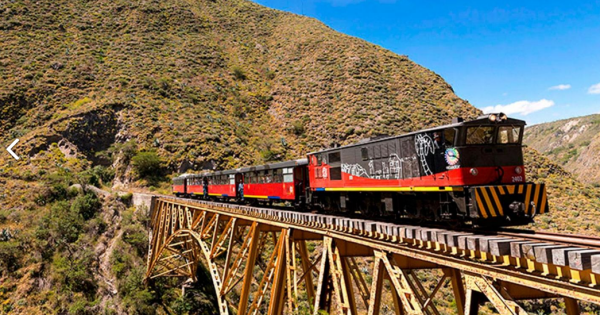The plan for a multi-purpose train is all but scrapped. The Government will rehabilitate six sections of the original railway system for tourism purposes.
The steam and the sound of the locomotives of the Ecuadorian train will return in 2023, says the Minister of Transportation and Public Works, Darío Herrera.
After the liquidation of the public company Ferrocarriles del Ecuador, which began in 2020 and ended in 2022, the Government has decided to reactivate six sections with high tourism potential.
Initially, the reactivation will be carried out with the state budget. But the Government is already in dialogue with two private companies to find a concession model that will allow the entire Ecuadorian railway system to be rehabilitated.
The Government had also suggested creating a new railway line for a multipurpose train that transports mining material, but the idea has for now been ruled out. The project would not be economically or technically viable, said Herrera.
In a recent interview, Herrera explained what the plan and next steps are for the railroad.
The transfer of assets of Ferrocarriles del Ecuador was completed. What’s Next?
Provide maintenance and better use of the assets we received. First, we must verify the status of each of these train cars. We only have 2% left to verify their condition.
What is the budget required to maintain the assets?
It is necessary to maintain the cars, turn on the machines from time to time so that the motors are not damaged, and clean. The budget for maintenance, guardianship and insurance is around $4 million in 2023.
We have 965.6 kilometers of railway road network. Of that total, only 118.9 kilometers are operational. In addition, we have 81 cars and 95 stations, of which only 35 are enabled.
What results did the consultancy you contracted with the IDB identify?
The consultancy identified several opportunities. One of them was that the train is good at carrying a lot of non-perishable cargo and moving it over long flat distances. There was also an opportunity seen to create a new network for transporting mining material.
But the problem is that we are a small country with a mountain range in the middle, the route would be very complicated. In addition, we already have a large supply of trucks that would compete with the load that the train could transport.
Is it viable to create this branch for mining transport?
This new branch that was being analyzed would have to move a lot of cargo and have at least 30 or 40 cars to transport copper concentrate. The route would be from Yantzaza (Zamora Chinchipe) to Puerto Bolívar (El Oro).
That is the opportunity that we identified in the IDB consultancy, but the route would imply crossing the mountain range, there would be many curves and it would not be possible to put many cars.
How much would this railway line cost for the mining sector?
The estimated investment would have been around $1.3 billion. It is very expensive and there are already trucks that transport the copper concentrate on that route.
Perhaps the mining companies could make this investment, but there is a social issue and that is that the employment generated today by the transport of cargo by trucks would be lost. The focus of [any] foreign investment must have a tint of social assistance and employment generation.
Is the mining train project ruled out then?
For this railway network to have an internal rate of return acceptable to the investor, between 8% and 10% per year, the project would need a state contribution of at least half of the required investment and the Government cannot do it.
What if I invest those $1.3 billion instead in fixing the road axis from Puerto Bolívar to Yantzaza?
It is something that we are analyzing. We haven’t made a decision yet. But the purpose of mass transportation of mining cargo is likely lost, and the project is currently not viable.
What will happen then with the plan to reactivate the railway?
Another opportunity identified by the IDB consultancy is in the transport of passengers for tourism purposes on the existing road network.
Our plan is to reactivate the train in sections, progressively in 2023, for tourism purposes.
What sections will be reactivated?
We want to reactivate, from the outset, the most touristic sections. We already have prioritized the first six stations that we will progressively enable from the first quarter of 2023.
The first route to be reactivated will be Alausí-Simbambe, [otherwise known as] the ‘Devil’s Nose’ train.
Then, Quito-Boliche; Ibarra-Salinas; Riobamba-Urbina; Tambo-Coyoctor and Durán-Bucay.
Has the business model to reactivate these sections and the entire network already been defined?
We do not want to rehabilitate a train whose operation generates losses. We have spoken with two large companies that are listed on the stock market and with extensive experience, to see concession options. One of them already has experience managing trains in Latin America.
We want to carry out a transparent public bidding process, which begins with the formal expression of interest from the companies.
But they are processes that take time. We cannot define the public-private partnership model, until the companies formally present their investment interest.
Will the reactivation of the six sections depend on that tender?
There are slow times, I can’t push the companies. Representatives of the two companies have already come and know the railway. While this process moves forward, the Government will restore the six sections.
We still have to make the budget for each section, so we are going to gradually open each one. There is the possibility that in each section we have some kind of alliance with the Autonomous Governments.


Epic